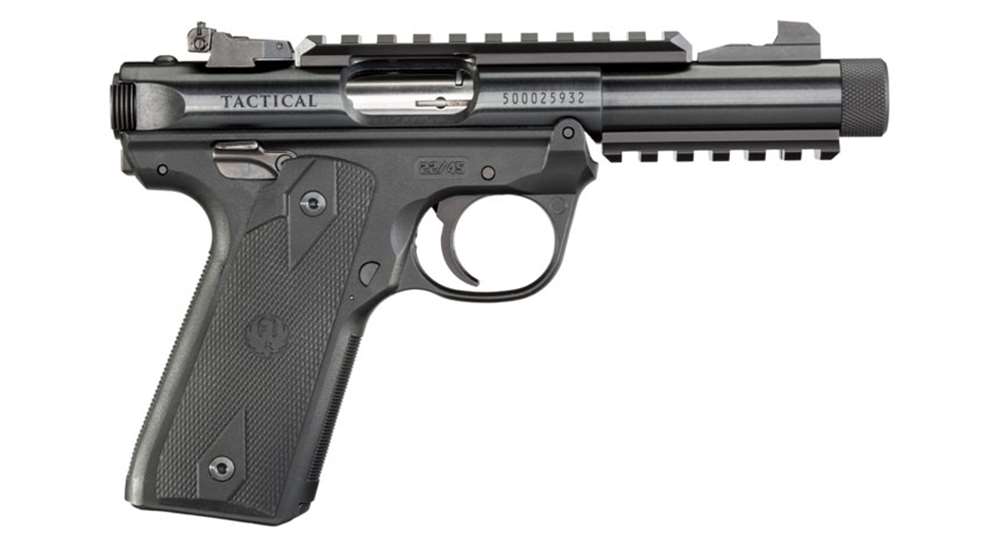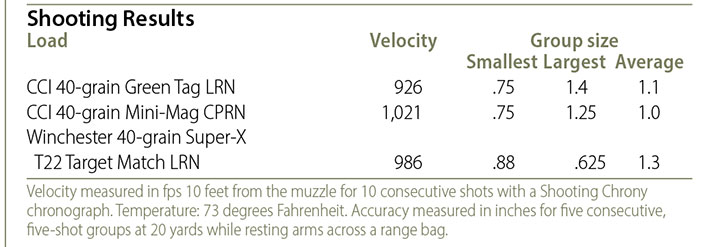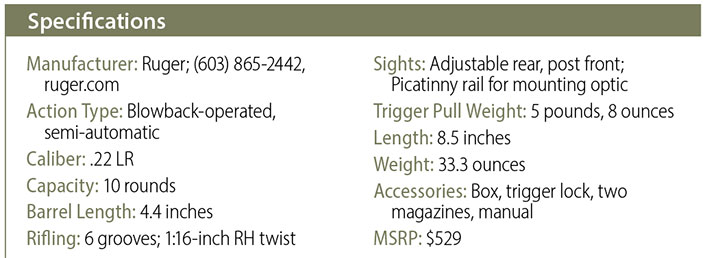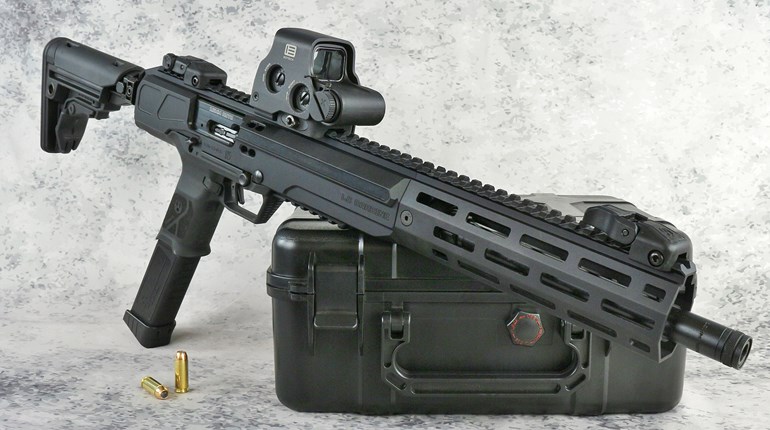
When looking at Ruger’s new Mark IV 22/45 Tactical .22 pistol, a line from my youth comes back to me. It goes something like, “From a tiny acorn, a mighty oak tree grows.” In 2019, Ruger celebrates its 70th anniversary, and like the mighty oak, this giant of the firearm industry began with something small, a .22 LR pistol that looked a bit like the legendary German Luger. It was the Ruger Mark I and cost $37.50.
Over the years, Ruger has made many changes to its little rimfire semi-automatic, two of which I think are pure genius. First, it designed a grip frame that made the gun feel and point like a 1911, and this model was appropriately named the 22/45. Second, the manufacturer adopted a simpler push-button takedown system, eliminating the spider web of internal parts that popped into view during disassembly and frightened any shooter who wasn’t a trained gunsmith. Ruger’s website markets its new Mark IV 22/45 Tactical as the “perfect tactical rimfire trainer.” The company absolutely hit this one out of the park.
Despite the near-cult worship of all things tactical in the 21st-century shooting world, I’m amazed at the lack of .22-caliber pistols involved in training new shooters. It’s in this environment where the humble rimfire shines at allowing a shooter to practice sight alignment and trigger press. And since the great rimfire ammo shortage seems to be over, this can be done for considerably less money than with any centerfire. Ruger paid close attention to the tactical market’s focus on self-defense in setting up the controls on this pistol.

As mentioned, the Ruger Mark IV 22/45 Tactical feels and handles like a full-size defensive pistol. Even with the polymer grip frame that recreates the 1911’s grip angle, the alloy-steel frame, barrel and external rails bring the gun’s overall weight up to 33.3 ounces. Ambidextrous thumb safeties can easily, in fact, be manipulated by the shooting-hand thumb, regardless of whether you’re right or left handed. The magazine-release button is on the left side of the gun like most semi-automatic pistols, and can be operated by the thumb with minimal movement. When pressed, the magazine drops clear of the frame, even when empty, allowing simulation of a speed reload. Since the gun is furnished with two magazines, a new shooter can practice this technique with an unloaded gun. Cuts at the rear of the frame give improved access to the bolt “ears” for easier manual operation.

Sights are large and easy to see, plus the rear sight is adjustable—allowing precise shooting of whatever brand of rimfire you select. The Picatinny-style rail on top of the pistol allows you to mount an optic, should you so choose. The rail under the barrel will accommodate either a weaponlight, a laser or combination of the two. There are some interesting benefits in having such a light mounted on a .22-caliber training pistol.
At a public indoor range with paper targets, we don’t think in terms of having to identify a target as a threat before shooting. Newer ranges are typically brightly lit with no dark spots, and the target-delivery system sends your target downrange smoothly with no bouncing at the stopping point, so you don’t need the brightness enhancement of a good weaponlight. Older indoor ranges, however, often do have dark spots, and a good weaponlight is a real advantage in seeing the target and your iron sights silhouetted against it. Even if you decide you don’t need a light on a .22-caliber training pistol, you absolutely should have one on a home-defense gun for proper target identification. Why not practice with one?
The Mark IV 22/45 Tactical also comes with a threaded barrel (and screw-on endcap to protect the threads) that will accept Ruger’s .22 LR sound suppressor along with models from other manufacturers.
When testing the gun for accuracy, I installed a Trijicon red dot on the top rail. With my old eyes, I can see the red dot much more clearly than iron sights and place my shots much more precisely. While it’s a huge advantage for me when handgun hunting, I’m not sold on the idea of putting an optic on a handgun intended for the purpose of self-defense, especially a concealed-carry weapon. While the groups below are not those of a Master Class bullseye shooter, they’re much smaller than had I shot the Ruger Mark IV 22/45 Tactical using iron sights. It’s your choice as to how you equip the pistol, which is why Ruger equipped it with the rails and threaded barrel.

Out of the box, the trigger felt a little gritty at first. Total trigger movement is about ¼ inch, with the first 1/8 inch being unresisted takeup of slack and the remaining 1/8 inch of travel requiring 5 to 5.5 pounds pressure on the trigger. As I went through the sight-in process and accuracy testing, the trigger pull seemed to smooth out a bit. Trigger reset was crisp and occurred in the first 1/8 inch of the trigger’s return travel. In short, the firing mechanism worked as designed, and had I cleaned the gun before heading to the range, I probably wouldn’t have noticed anything about the trigger. The only mishaps were two failures of the bolt to lock open after firing the last shot in the magazine; again, probably related to the lack of proper initial cleaning.
The only other incident was definitely caused by operator error. During a reload, the heel of my shooting hand slipped slightly below the frame preventing the empty magazine from falling clear of the pistol. If you have to move your shooting hand to hit the magazine-release button, make sure you do it in such a way that you do not block the empty magazine’s exit. If this happens, simply move your hand away from the grip and strip the empty mag from the gun with your support hand before inserting a full mag. Thanks to having ergonomics and a fire controls similar to a 1911, the Ruger Mark IV tactical allows you to hone your defensive-shooting skills without breaking the bank.




































